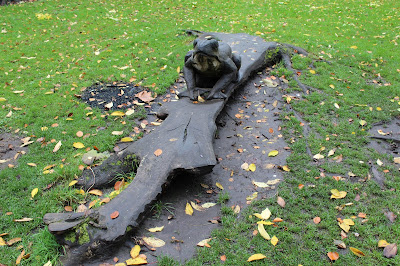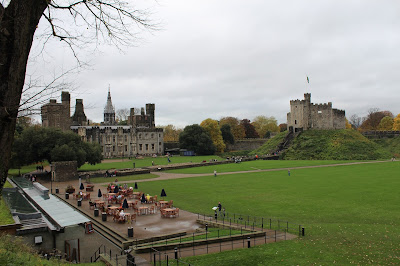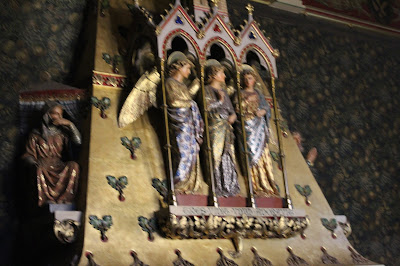Having seen some of the palaces around London, it was exciting to finally see an actual old castle in Cardiff. The site it sits on has a rich history dating back at least 2000 years. You can read a super quick history of it
here.
The grounds within the walls are huge - you can easily imagine the scores of structures that would have been build and replaced over the centuries, and the thousands of people who would have lived and died here. Historical sites such as these never fail to impress me with their size.
We started our explorations with a walk around the battlements. It was a bit surreal to look out at modern Cardiff from within such ancient walls, and it was fun to imagine what it would have looked like hundreds of years ago when it would have been smaller building, or even earlier when it may have been forests or plains.
We wandered down some stairs inside the gatehouse, expecting to come out on the ground level outside. Instead we find ourselves inside the walls themselves. I can't properly convey just how eerie and cold it was in there - the lights were dim and our breath came out in clouds. For a long way there was nothing to see except small windows to the outside. Eventually we turned a corner, and suddenly we hear the sounds of an air raid. Planes flying by overhead, bombs dropping in the distance, alarms sounding. It was very confronting. But it would soon become even more confronting.

As we are walking along, we start seeing signs on the walls. These signs describe how the inside of the castle walls were used as bomb shelters during WWII. Hundreds of people would gather inside them, sleep inside them, when there was a raid. We start seeing pictures on the walls from that time - some depicting how good it is to be in the army, protecting your country; some depicting how women back home can help their country by growing vegetables, sewing for the army or hospitals, to 'make do and mend'; but most are simple images of people talking with text saying things along the lines of 'save your tongue to save lives', with the distinct feeling that people need to be extremely careful what they talk about in war time, even with those they think they trust completely.




In alcoves along the walls are scenes laid out to show life inside the walls, and in one section there are the metal frames of bunk beds. Top this with recording of radio announcements from back then, and the entire place is so confronting it almost made me cry. Youth today, myself included, have no idea of war. We have no true understanding of what it's like. I hope we never will.
We leave this dreary exhibition and walk outside into the castle grounds again. It was refreshing to see happy people playing with their children.
We decided the next thing to do was explore the castle keep itself. Up to the front we go, realising as we get nearer just how steep the steps are. To the left of the beginning of the steps is a small roofless room, within which is an ancient well. A little girl surprised us all by speaking into it and extracting a huge echo. Up the steps we went, holding carefully to the rail and stopping many times to let people past going back down. The steps are stone, and worn down in so man places that they are covered in puddles of water, which makes them very slippery. In through the door we go, to enter the inside of the keep. The roof has long eroded away, leaving a large circular space full of stones and grass. You can see the chimney of the great heath extending all the way to the top, where a pair of pigeons were sitting quite comfortably grooming each other. You can only imagine how the inside of the keep may have been laid out - there is no indication on the ground as to where walls may have been, if there were any in this space. There is also no real indication on the walls to where floors may have been, so who knows if this inside space was just one great area, or if all the supporting structures have disappeared over time.









On one side of the wall is an extremely steep staircase, with steps so narrow you can barely fit your foot sideways on them. We clambered up these very carefully, into a room that was once perhaps a bedroom. Some of the original plater was still attached to the wall, and there was even a toilet set in an alcove, dropping away from the outside of the keep into the moat. There was an information display showing how the room may have been set up when it was in use, and a door leading to a small balcony from which you could see right across the grounds. In one corner of the room was another set of very thin stairs leading up to the roof - we chose not to go up that far (fear of heights and all). Coming back down the stairs to the ground level of the inside of the keep was one of the most nerve-racking things I've ever done. I gripped the rail so tight I could have snapped it. The worst part was that you had to look at your feet to see where the steps are, because they are so thin you could easily over-step them, and the whole staircase moves just a little. Luckily I had watched a bunch of children climb down carefully, so I copied their technique and made it to the ground safely.




From here it was back down the first set of stairs, just as slippery as the way up, and into the castle grounds again. We then explore the inside of the rest of the castle. We are only allowed access to a few rooms, but these rooms are so exquisite that you are overwhelmed anyway. The decoration is absolutely incredible. Rather than discuss the details here, I will simply show you what we saw. We went through the banquet hall, private dining room, Arab room, sitting room, and library.
Even though we have no real knowledge of the history of Cardiff, it was still incredible to explore this ancient site. Being right in the centre of the city makes it incredibly easy for visitors to see it for themselves, and I would highly recommend it to anyone who get the chance. You could spend as little as an hour here and see everything quickly, or as much as a day exploring fully.

































































